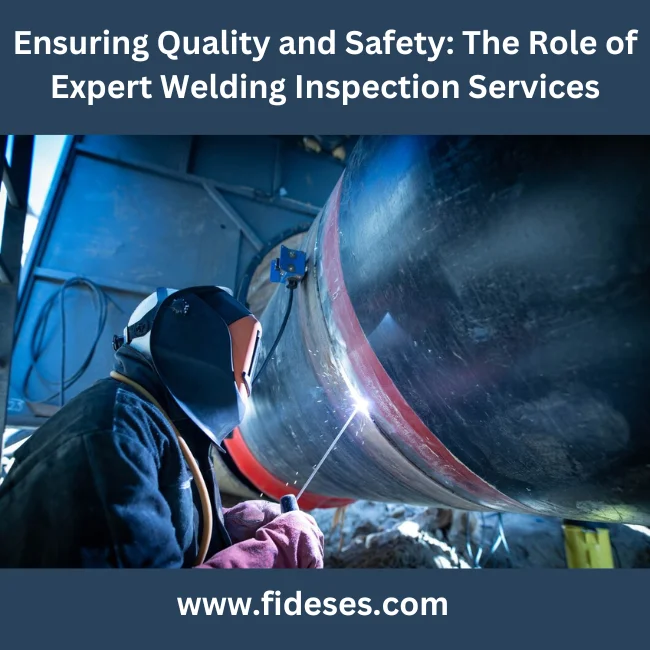Specialist Welding Inspection Services in Gilbert Arizona: What You Required to Know
Specialist Welding Inspection Services in Gilbert Arizona: What You Required to Know
Blog Article
Discovering the Importance of Welding Inspection in Industrial Applications: Guarding Against Failures and Enhancing Durability
Welding inspection serves as a critical line of defense in commercial applications, ensuring the structural stability and integrity of welded elements. By methodically identifying defects such as porosity and insufficient fusion, evaluations not only stop failings but also prolong the life-span of essential possessions. Abiding by sector criteria boosts both safety and operational effectiveness; nonetheless, the effects of neglecting these practices can be severe. As we analyze the complex advantages of normal examinations, it becomes evident that understanding these characteristics is not simply an issue of conformity however a calculated important for longevity and risk mitigation (Welding Inspection Gilbert Arizona).
Function of Welding Evaluation
Welding inspection functions as a crucial safeguard in commercial applications, making sure that welded frameworks fulfill defined standards of top quality and security. This process entails a methodical assessment of welds to verify their honesty, stamina, and compliance with well-known codes and specs. The function of welding inspection is multifaceted, incorporating both visual analyses and non-destructive testing techniques, which might consist of ultrasonic, radiographic, or magnetic bit screening.

Furthermore, welding examination plays a crucial function in governing compliance. Eventually, the function of welding examination is indispensable in promoting safety, enhancing performance, and safeguarding investments in industrial infrastructure.
Typical Welding Defects

One of the most common problems is porosity, characterized by small gas pockets trapped within the weld metal. This occurs because of pollutants or inappropriate protecting gas, jeopardizing the weld's strength. An additional substantial defect is insufficient blend, where the weld metal fails to bond correctly with the base material, possibly bring about architectural weaknesses.
Cracks can additionally create during or after the welding procedure, frequently credited to thermal stress and anxieties or incorrect cooling prices. In addition, undercutting, where the base steel is worn down along the weld bead, can damage the joint and is commonly brought on by excessive heat input or incorrect technique.
In addition, lack of infiltration happens when the weld steel does not reach the origin of the joint, causing inadequate stamina. Understanding these usual defects is critical for welders and examiners alike to make sure that bonded structures fulfill safety and efficiency standards, inevitably stopping possible failures in commercial applications.
Advantages of Regular Assessments
Regular assessments work as an important safeguard in making sure the integrity and longevity of bonded frameworks. These assessments recognize possible problems and weak points that might endanger the integrity of welds, permitting prompt removal before issues intensify. By applying an organized evaluation regimen, companies can considerably minimize the risk of catastrophic failings that may result in pricey downtime, equipment replacement, or even crashes.
Furthermore, routine examinations add to enhanced high quality control throughout the welding process. By adhering to a regular inspection schedule, companies can guarantee that their welding methods satisfy well established top quality benchmarks and best practices. This not just cultivates a society of liability yet additionally urges constant enhancement amongst welding workers.
Furthermore, routine evaluations promote better maintenance preparation. By determining wear and tear early, companies can tactically schedule replacements and repairs, decreasing interruption to procedures. This proactive strategy eventually results in extended property lifespan and boosted general performance.
Finally, a commitment to routine evaluations can boost a company's online reputation in the market. Stakeholders and customers increasingly worth organizations that focus on safety and top quality, thereby improving trust and potentially causing increased service opportunities.
Market Requirements and Regulations
Sticking to market requirements and regulations is a fundamental element of welding evaluation that complements the benefits of routine examinations. These standards, developed by companies such as the American Welding Culture (AWS) and the American Society of Mechanical Designers (ASME), provide a framework for best techniques in welding procedures, materials, and evaluation strategies. Conformity with these regulations guarantees that welds satisfy the called for quality and safety standards, dramatically reducing the risk of structural failures.
Regulative bodies like the Occupational Safety And Security and Wellness Administration (OSHA) further enforce guidelines that safeguard workers and the atmosphere during welding operations. By complying with these developed requirements, markets can improve the dependability of their frameworks and elements, guaranteeing they carry out as intended under various functional problems.
In addition, adherence to sector requirements cultivates uniformity in quality assurance, promoting smoother interaction amongst stakeholders and regulative companies. This positioning not just lessens obligation risks but also boosts the trustworthiness of companies in open markets. Eventually, compliance with welding standards and laws is not just a lawful responsibility; it is an important investment in security, performance, and lasting operational success.
Future Trends in Welding Inspection
As sectors proceed to develop, the future of welding inspection is positioned to integrate innovative innovations that improve accuracy and effectiveness. Among one of the most significant fads is the adoption of automation and robotics in evaluation processes. Automated systems can carry out evaluations swiftly, lowering human error and raising throughput in producing environments.
In addition, the integration of fabricated intelligence (AI) and artificial intelligence formulas will allow anticipating analytics, enabling real-time analyses and proactive upkeep (Welding Inspection Gilbert Arizona). By analyzing data from previous examinations, these innovations can recognize patterns that could indicate potential failings, consequently prolonging the life-span of welded parts

Additionally, the fad in the direction of digitalization will certainly lead to improved data administration systems that promote far better tracking, reporting, and compliance with market requirements. In recap, the future of welding inspection is characterized his comment is here by technological improvements that assure to dramatically improve dependability, security, and functional performance in numerous commercial applications.
Verdict
In conclusion, welding inspection serves an important function in guaranteeing the integrity and basics toughness of bonded frameworks throughout various commercial applications. By recognizing defects such as porosity and insufficient blend, normal assessments play a substantial role in danger mitigation and top quality assurance. Adherence to industry standards and regulations better boosts operational safety and security and integrity. As improvements in innovation continue to evolve, the future of welding examination promises raised accuracy and efficiency, ultimately adding to the durability of vital infrastructures.
Welding inspection offers as an essential line of defense in commercial applications, making sure the structural honesty and dependability of welded parts.Welding evaluation offers as an essential secure in industrial applications, making certain that bonded structures fulfill specified criteria of top quality and safety - Welding Inspection Gilbert Arizona. Inevitably, the role of welding assessment is important in promoting safety and security, improving efficiency, and safeguarding financial investments in commercial framework
These standards, developed by organizations such as the American Welding Culture (AWS) and the American Culture other of Mechanical Engineers (ASME), give a framework for ideal techniques in welding processes, products, and inspection methods.In final thought, welding examination serves a crucial feature in ensuring the stability and longevity of welded frameworks throughout different industrial applications.
Report this page